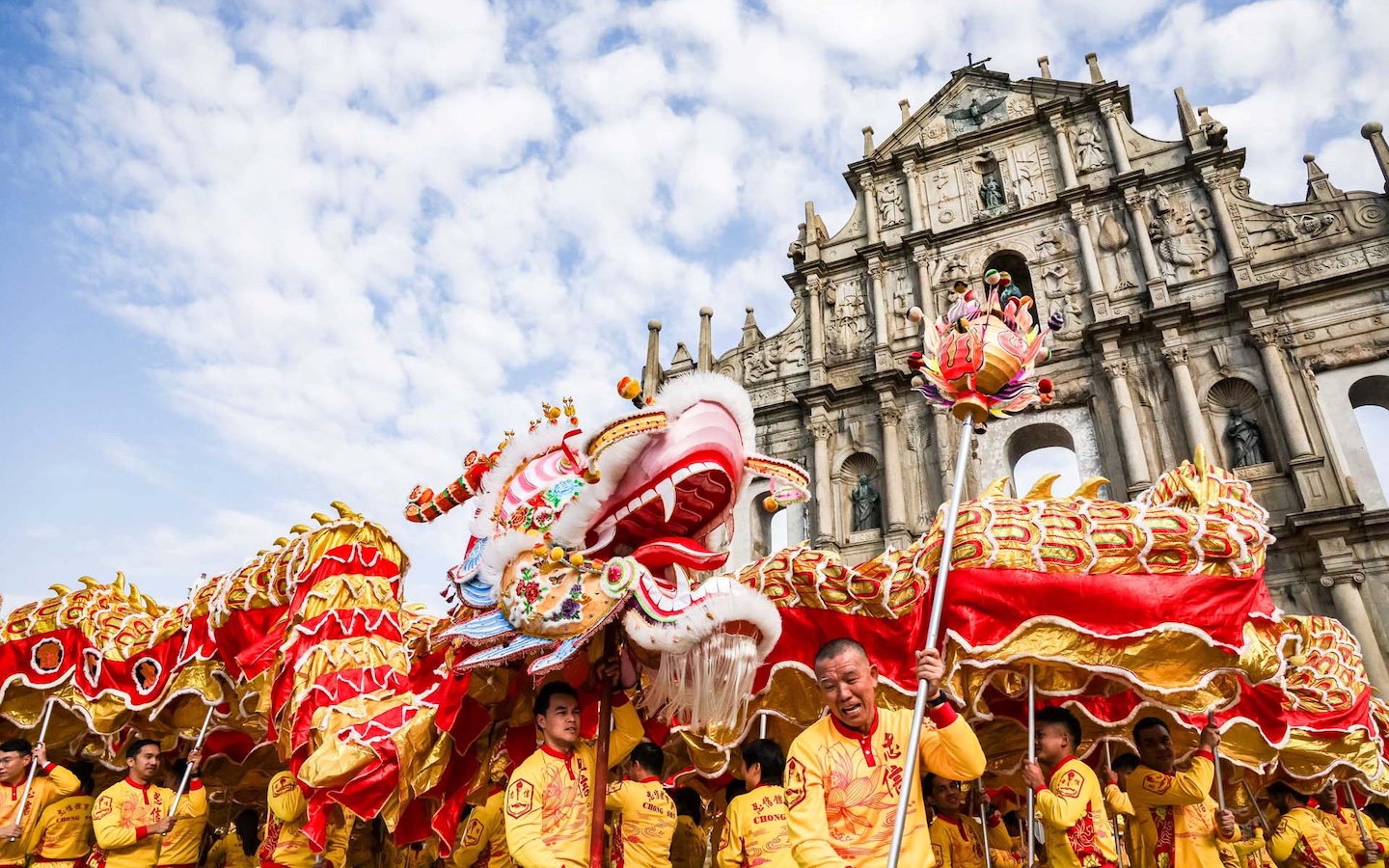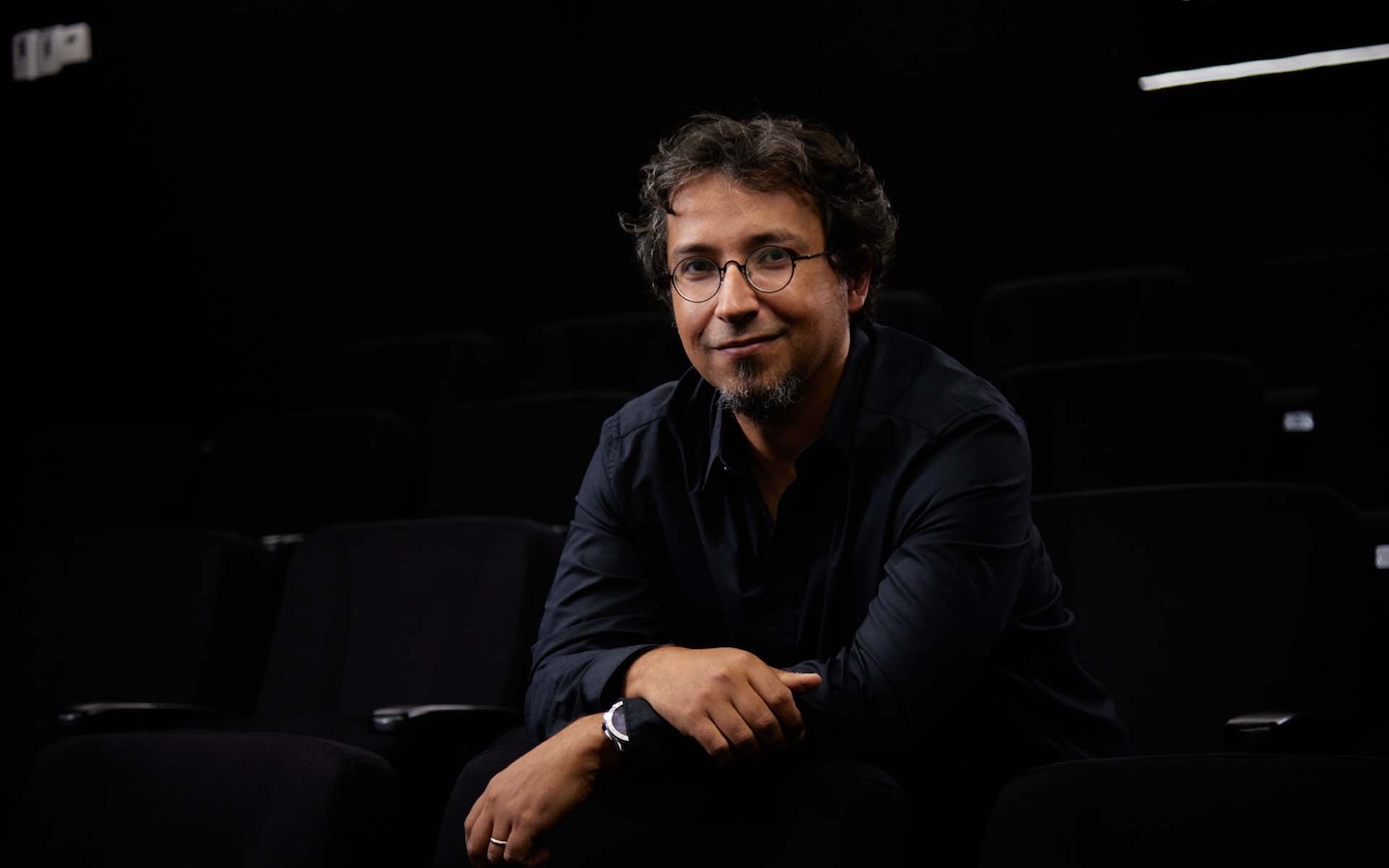For the past six decades, much of the Macao-born ceramic artist Lei Iat Po’s life has revolved around Guangcai porcelain. He’d always been into painting; the 70-year-old recalls his grandfather rewarding him for a particularly beautiful goldfish he’d painted as a young boy. Later, he worked at his father’s porcelain factory in Areia Preta, in the north of Macao. Then Lei went on to open his own Guangcai operation in the mainland before returning to Macao.
Guangcai, also known as Cantonese porcelain, is an elegant style of ceramics characterised by its fine quality, gilt and bold colours. Traditionally manufactured for foreign markets, the centuries-old craft is known for combining Eastern and Western imagery. While Guangcai first emerged more than 300 years ago, on the mainland, the mid-late 20th century saw it boom in Macao. It became an important yet relatively short-lived export industry for the city.
Lei is one of few practitioners left in Macao, and fears the artform is at risk of being forgotten. His efforts to keep Guangcai alive and relevant have earned him numerous awards – including a National Craftsman Cup (gold) at the GHM Greater Bay Area Arts and Crafts Expo in 2018. That same year, he was recognised as a Macao Arts and Crafts Master by the Macao Arts and Crafts Association, with a judging panel composed of Guangcai experts from the mainland. Guangcai itself made it onto Macao’s list of Inventory of Intangible Cultural Heritage in 2020, to Lei’s intense satisfaction.
‘Weaving gold’ into porcelain
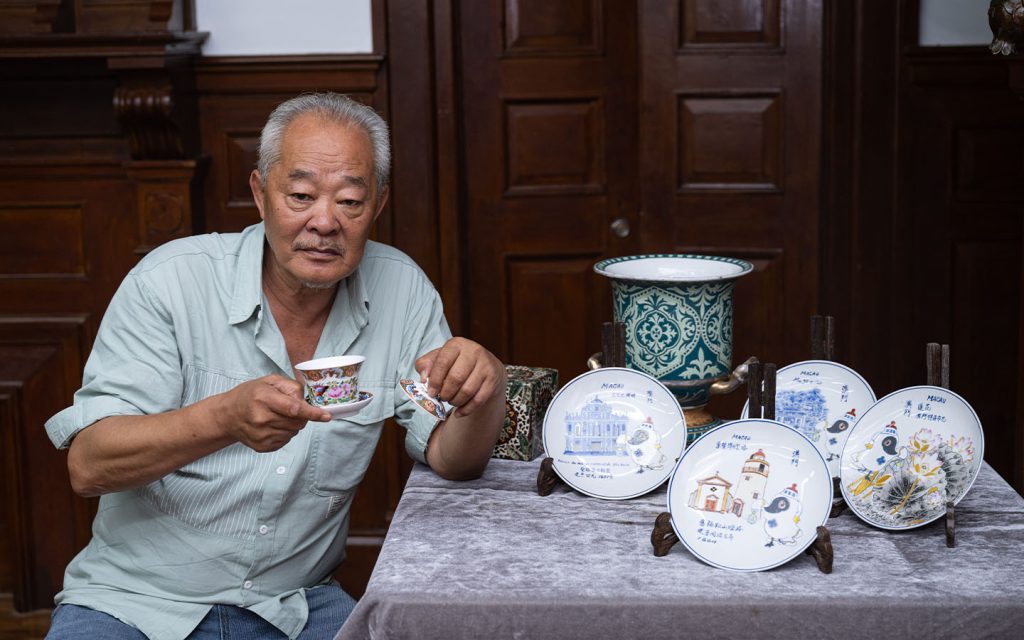
Guangcai porcelain was invented during the Kangxi period of the Qing dynasty. An art lover, the Kangxi Emperor invested heavily in China’s ceramics industry. It was he who reopened the imperial kilns of Jingdezhen, in Jiangxi Province. The country’s porcelain capital had been neglected prior to his reign.
While Jingdezhen’s exquisite white porcelain laid the foundation for the Guangcai tradition, Guangcai itself originates in Canton (now Guangzhou), Guangdong Province. Porcelain ‘biscuits’ (bowls, vases and plates that had been shaped and fired but not yet glazed) were transported from Jingdezhen’s kilns to workshops in Canton for embellishment. That process involved skilled Guangcai craftsmen meticulously applying lavish gold trim to a biscuit’s still-porous surface to achieve the glitzy hallmark of Guangcai porcelain, then overglazing it with colourful, auspicious imagery depicting the likes of pak choi, butterflies, birds, flowers, and roosters (often to the bespoke demands of Western traders). A second firing followed, at a subdued temperature, giving the resulting piece its luxuriant sheen.
Guangcai is sometimes described as being ‘woven with gold and layered with jade’. Weaving with gold is in reference to what Lei believes to be the ceramic style’s aesthetic inspiration: Cantonese embroidery. “In Cantonese embroidery, gold threads are woven on the cloth as a base layer,” he explains. “On top of that, you embroider auspicious motifs, such as dragons, phoenixes, bats, fruits and flowers. The composition is dense and rich in imagery.”
Guangcai was one of China’s staple exports when the Canton System (1757–1842) was in place – the period when all foreign trade flowed in and out of Guangzhou.
How Macao’s own Guangcai master learned his craft
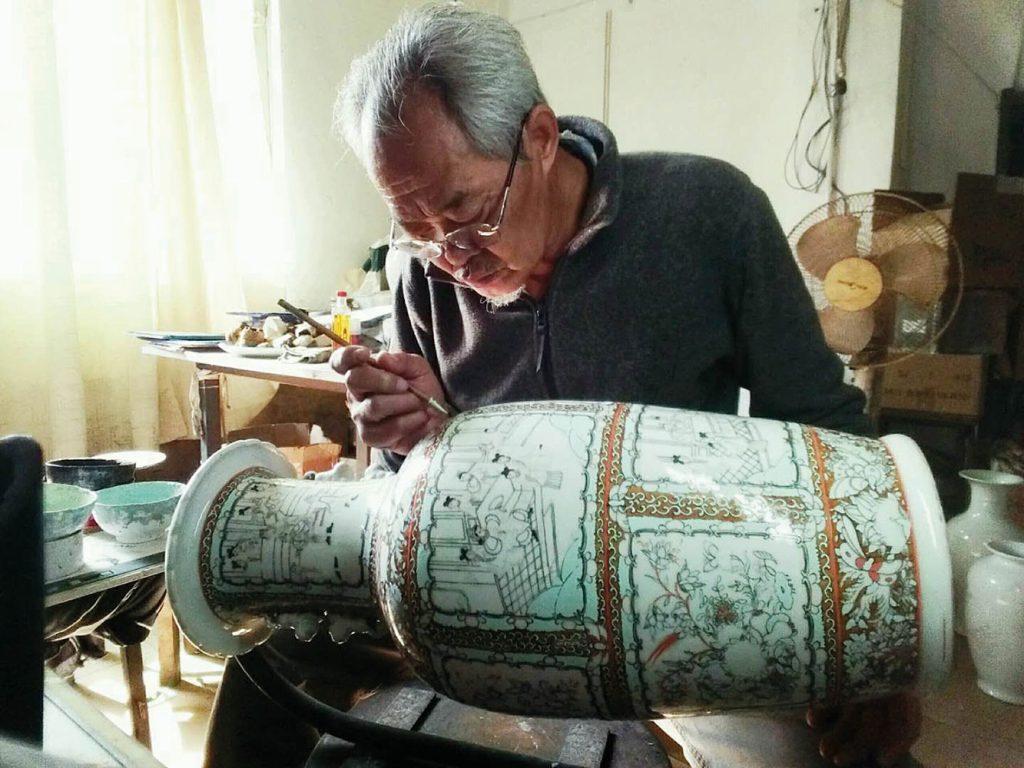
During World War II (1939–1945), a lot of Guangzhou’s Guangcai porcelain factories shut down. Many of their workers fled to Macao and Hong Kong, where they put their knowledge and skills to good use and introduced both cities’ existing ceramicists to the specialised techniques of Guangcai. According to Lei, most of Macao’s porcelain factories were based along Rua de Pedro Nolasco da Silva, in central Macao, at the time, and northern Macao’s Areia Preta. Their customers were mainly based in the US and Europe.
Lei’s father worked closely with the Rua de Pedro Nolasco da Silva ceramicists in the 1960s; he made the wooden bases used alongside porcelain wares. As kids, Lei and his brothers would help out at these factories. He clearly remembers the excitement of being 7 years old and earning enough money to visit the cinema.
In 1974, his dad opened his own porcelain factory. Lei moved into it and began observing the Guangcai artisans at work. In his eyes, the whole process was fascinating. Soon, his father asked a master kiln operator with the surname Chiu to teach Lei how to fire the glazed ceramics. Chiu had some rather unorthodox advice for his apprentice: start smoking cigarettes.
“Back then, there was no thermometer,” Lei says. “I had to man the kilns by watching the intensity of the flame, and Chiu said the best way to pick up that skill was to learn to smoke. From cigarettes, I learned to discern the intensity of a flame, and that helped me judge if the kiln was at the right temperature.”
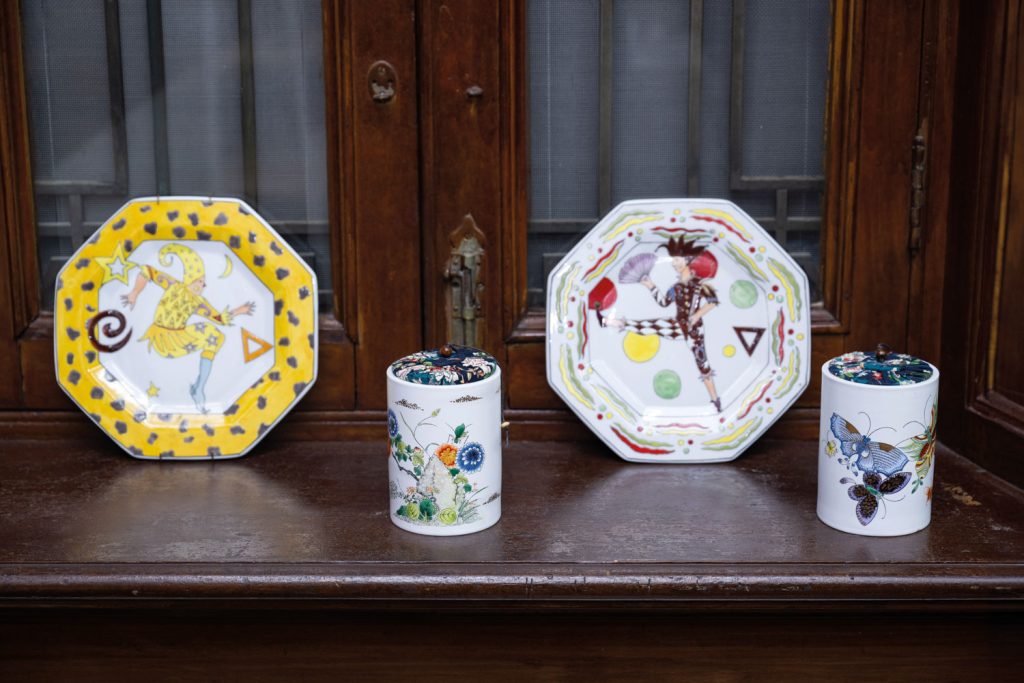
If the flame burned too hot it would damage the porcelain, and the wares would be thrown away “like rubbish”, says Lei. A kiln that wasn’t hot enough, meanwhile, would fail to produce the waterproof, shiny surface required of Guangcai.
These days, kiln temperatures are regulated automatically and “it is certainly more convenient,” Lei notes. “You can set the timer and go to sleep.” But the craftsman is grateful he learned the hard way, believing his hands-on experience at the kiln to have made him better at his job.
After mastering the kiln, Lei learned how to apply gold paint to porcelain’s edges. And that was as far as the factory workers were prepared to teach him. Lei summed their reluctance up with an old Cantonese saying: “When a student learns the knowledge, the teacher will lose their job.” Instead of painting roosters and pak choi, he was relegated to unpacking the endless boxes of white porcelain biscuits arriving from the mainland and Japan (Jingdezhen had long-lost its monopoly on making porcelain by Lei’s time; high quality products could be sourced from elsewhere in the mainland and overseas).
In the end, Lei taught himself how to execute the Guangcai painting style. He’d diligently practise in his own time, leaning into the natural artistic talent he’d shown as a boy.
Transitions

By the early 1980s, the mainland’s Guangcai industry had bounced back. The tides changed: stiff competition from Guangdong Province forced many of Macao’s Guangcai factories to shut up shop, or switch to producing other products. Lei’s father’s factory began sewing garments, for instance. This came as a blow to Lei, who loved the art of Guangcai. But he knew he needed to be pragmatic: by then he had his own family to feed. So, he put his artistic aspirations on pause to work first as a button maker, then for Banco Nacional Ultramarino.
As it turns out, he didn’t stay away from Guangcai for long. In 1986, Lei and a number of other Macao ceramicists banded together to capitalise on Guangdong’s Guangcai boom. They established their own porcelain factory in Zhuhai, initially sharing a furniture merchant’s premises. The business grew quickly. Before long Lei’s factory was employing 300 workers, who did everything in-house: from manufacturing the fine porcelain biscuits to painting Guangcai’s signature designs.
By the end of the 1990s, Guangcai market was overcrowded. Lei’s enterprise couldn’t stay afloat amidst all the rival factories, and supply was outstripping demand. Again, he was forced to pivot – though not so dramatically this time. Lei reinvented himself as an independent, small-scale maker and teacher of Guangcai porcelain.
These days, Lei works out of a studio in Zhuhai while also conducting ceramics classes for hobbyists in local arts centres like Porcelarts Macau. The year 2023 was a big year for him. Not only was he was invited by the Centro de Cultura e Artes Performativas Cardeal Newman de Macau to hold a series of Guangcai painting workshops (as part of the event, “Reuniting Porcelain: An extended experience of Macao’s Canton Porcelain”), he also staged his first solo exhibition at local creativity incubator 10 Fantasia.
Lei titled his show “Kong Ngee Guangcai”, the name of his father’s old porcelain factory (meaning ‘the art of light’). “That show was only about me,” he says. “But I hope to witness more exhibitions of Macao-made porcelain artwork in my lifetime. More exhibitions about the industry.” Lei points out that Macao already plays host to many ceramics exhibitions of remarkable work from the mainland and Hong Kong. In his view, it is important to showcase home-grown porcelain, too.
Looking to the future
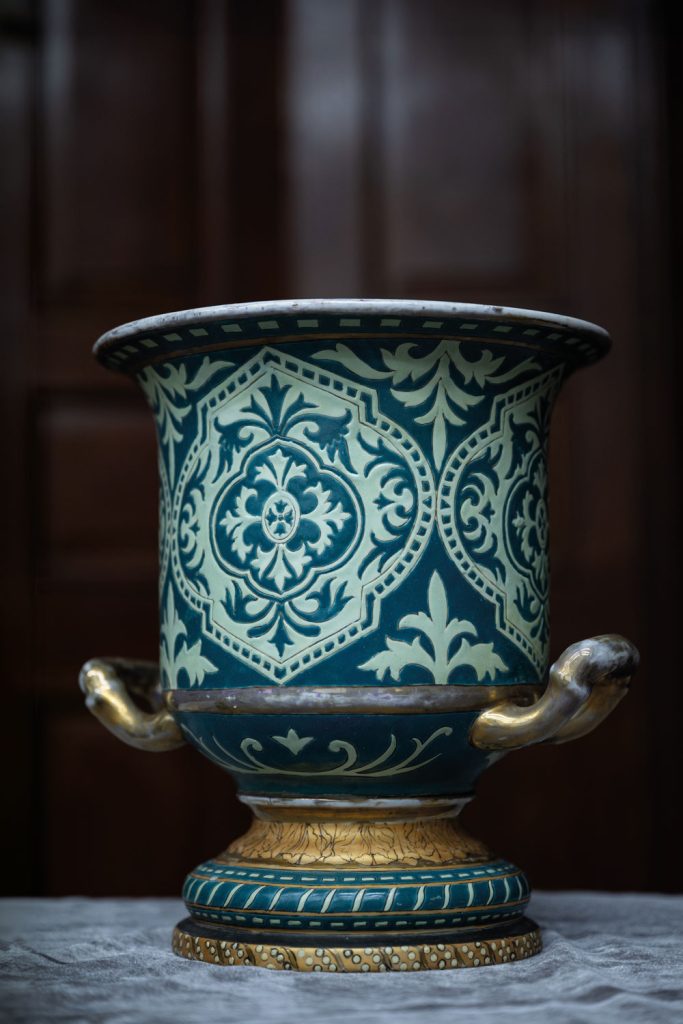
There are about 40 of the old Guangcai masters left in Macao, according to Lei. The men stay in touch via a WeChat group, of which he – already a septuagenarian – is the youngest. Lei admits he’s worried that the delicate art of Guangcai will someday vanish in Macao, along with his generation. There aren’t many people with the time and energy to master such a painstakingly precise craft: just learning to paint decent Guangcai-style designs can take up to a decade, Lei sighs.
Ideally, he would like to see the government do more to subsidise and promote what he believes is a unique part of the city’s artistic heritage: “It certainly carries significance,” he says.
When Lei reflects on other industries that have fallen by the wayside (fireworks manufacturing and shipbuilding are examples), he says he sees the efforts taken to celebrate and honour their contributions to the city. Both the former Iek Long Firework Factory and the Lai Chi Vun Shipyards have been turned into museums of sorts; they are places where people can gather to learn about fascinating yet often overlooked chapters of Macao’s history.

